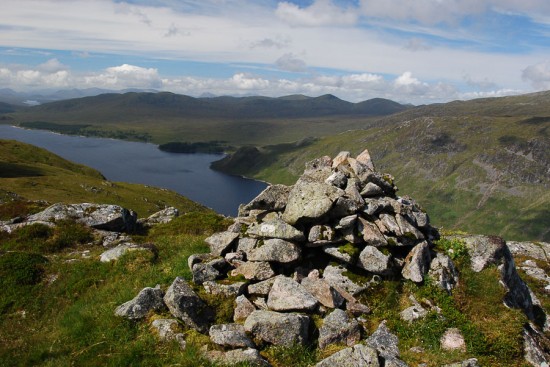Mountaineers and conservation groups have written to a Dutch firm calling for it to respect Scotland’s most precious wild lands and abandon plans for an industrial scale wind farm.

View from Ston an Aonaich Mhoir – the approach would be through the windfarm
Eventus BV, through a wholly-owned UK subsidiary Talladh a Bheithe Wind Farm Ltd, has applied to build 24 wind turbines, each 125m tall, together with 12.8km of wide access tracks, buildings and infrastructure, in Rannoch, Perthshire, in one of the most celebrated and beautiful areas of the Scottish Highlands.
The application was made the very day the Scottish Government declared that such areas, formally recognised as Wild Lands by Scottish Natural Heritage (SNH), should be better protected from development.
The Talladh a Bheithe wind farm plans have caused such anger that they have led to:
– Nearly 1,000 formal objections
– A debate in the Scottish Parliament
– International opposition including from best-selling Outlander author Diana Gabaldon
– The formation of a major local campaign to prevent the wind farm
– A poll showing opposition from three out of four local residents
– Strong opposition from statutory bodies Scottish Natural Heritage and Scottish Environment Protection Agency – the key government agencies charged with advising Government and protecting the natural environment.
Among the leading opponents are the Mountaineering Council of Scotland (MCofS), The John Muir Trust (JMT) and Keep Rannoch Wild. All three are now calling on developers Eventus BV to abandon the plans which would destroy the special landscape qualities of one of Scotland’s last remaining and most loved areas of wilderness.
There is growing evidence that the wind farm would do grave harm to wildlife, including an estimate by SNH that the turbines will kill a golden eagle – one of Scotland’s rarest species and recognised as a Category 3 Species of European Conservation Concern – every 19 months. Otters, ospreys and other species would also be endangered.
The development would affect views from more than 30 of Scotland’s highest mountains (known as Munros). These include the famous Schiehallion, the Ben Alder massif, mountains above Glen Lyon, the Drumochter Hills and Buachaille Etive Mor. The turbines would also be visible from the iconic West Highland Railway line and the A82 road – the main tourist route through the West Highlands.
David Gibson, chief officer of the Mountaineering Council of Scotland, which represents Scottish mountaineers and hill walkers, said: “Wind energy is supposed to help us protect the environment – not ruin the most precious and beautiful parts of our country.
“We are calling on the developers to recognise that this application has been a huge mistake – something that is absolutely clear from the enormous level of opposition it has caused. Only by withdrawing this misguided, damaging and unwanted proposal can they make it clear that they, and their industry, have a genuine commitment to protecting the environment and are not just trying to make vast profits at the expense of Scotland’s natural heritage.”
The John Muir Trust, has described the scheme as “a knife in the heart of Scotland’s natural beauty”.
Helen McDade, JMT Head of Policy, said: “Not only is this one of Scotland’s most stunning areas of wild land but the site is on a deep peatbog which locks carbon into the soil. Ironically, this wind development will release excessive carbon into the atmosphere – the opposite of what such renewable energy schemes are supposed to do.”
Residents and local businesses are deeply opposed to the project. The local economy is highly dependent on tourists who visit the area for its wild and unspoiled qualities, to climb mountains, go walking and see the wildlife. If these are harmed, sustainable jobs in a fragile economy would be threatened.
Douglas Wynn of Keep Rannoch Wild said: “This is a speculative and totally insensitive proposal which would do great damage – if by any unfortunate chance it was allowed. It is strongly opposed by most residents and also by all nine sporting estates in Rannoch which have expressed a view. We ask the applicant to listen, and respect their neighbours’ opinions.”
Leading Members of the Scottish Parliament are also supporting the call for Eventus BV to withdraw its planning application.
Murdo Fraser MSP, who initiated a debate in the Scottish Parliament on 30 September, said: “Rannoch Moor is a place of incredible unspoilt beauty and although renewable energy has a place it is certainly not here.
“I welcome the efforts of the John Muir Trust, the Mountaineering Council of Scotland and Keep Rannoch Wild who are lobbying the Dutch developer, Eventus, to withdraw their application. I would encourage Eventus to think again on their application at Talladh-a-Bheithe as the considerable level of opposition underlines the public’s desire to keep Rannoch wild.”
Michael McMahon MSP, who spoke in the debate, added: “The Talladh wind farm would transform Rannoch for the worse. The threat is not just to this magnificent Highland vista, but to rare bird species.
“We must protect our nationally important and scenic landscapes or they will continue to fall victim to the onward march of the renewables industry. Wind farms have a part to play in our energy production capacity but I am far from convinced that the right balance is being struck between their development and the protection of our wild lands.”
